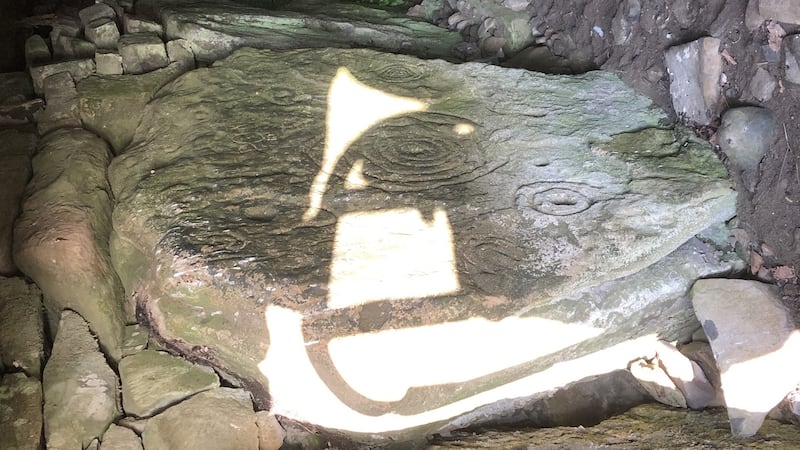I came early to the Hill of Tara on a sunny late-summer morning, my only company a solitary runner, glistening dew-wet grass, some raucous crows and distant, muffled traffic on the M3. I was keen to experience the place before the inevitable tour buses and forecasted rain arrived. While I've wandered most of the Irish hills, I'm embarrassed to admit that this was my first visit to the most iconic and historic "Hill" of them all.
My first stop was just inside the entrance gate from the CP at the formidable battery of information panels there. These are a careful, de rigueur read for any visitor, well worth the necessary 10 minutes of attention and perhaps photographs for reference as the site reveals its wonders to you.
Before I came my only knowledge of Tara was some vague ideas of High Kings and battles and St Patrick and the Trinity and the shamrock. And still, though now a better informed, my imagination can not grasp the great longevity of the place in terms of comings and goings of peoples and their languages and customs and ideas and doctrines and their power struggles, political alignments and confrontations.

Especially hard to connect with, on this morning full of sunshine and birdsong in AD 2019, was the historical and archaeological evidence of battles and violent death and the countless sad processions of fellow human beings all around where I stood; for virtually all of them, their memory and human stories, are lost to us now, like the blown-away smoke from their campfires and ancient funeral pyres.
I walked anti-clockwise around the perimeter of the site, past the northern end of the avenue known as the “Banquet Hall”, through the wooded tangle of Iron and Bronze ages barrows of the “Sloping Trenches”, and on along the great raised rim known as “Ráith na Ríg” past whitethorn “fairy” trees bedecked with hopeful ribbons and charms.
Soon I was presented with the heart of the site, the venerable “Mound of the Hostages”, reconstructed after invasive excavations in the 1950s and ’60s, with its many poignant burials and decorated stones, and the “Forrad” and the storied standing stone of “Lia Fáil”, with its connotations of fertility and investitures – and, much more recently, of 1798 and the slaughter and burial nearby of 400 fallen United Irishmen.

I crisscrossed the site and its often slippery slopes over two hours, seeing it fill up with groups and guides and dog walkers and even family runners. I listened in to the efforts of guides atop the “Forrad” struggling to convey a snapshot of Irish history and the subtleties of Tara down through the ages to non-European visitors; I visited the Síle na Gigh in St Patrick’s churchyard and called into the Visitor Centre, went for coffee and a scone in the adjacent Maguires of Tara.
And I wondered why I had never before engaged up close with the story of this truly awe-inspiring and evocative place.
Hill of Tara, Co Meath
Map: none needed; selection of tours from Heritage Ireland
Effort: exploration of site will take about two hours; tours about 40 mins
Suitability: easy, some slippery ground
Facilities: Maguires of Tara










